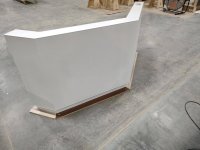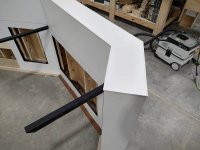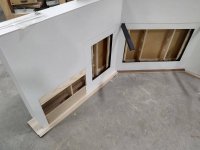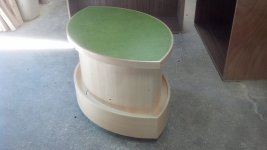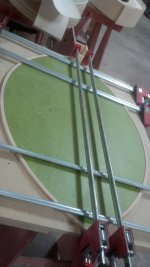Crazyraceguy
Member
- Joined
- Oct 16, 2015
- Messages
- 5,519
Over the years, I have built some ugly or bad-functioning stuff, all at the whim of the architect. Sometimes they can be coached out of bad things, other times they just dig in and insist.
This is one of those. It's a fairly simple little thing. A couple of miterfolds on the outside corners, but no biggie, done it a thousand times. Under normal conditions, this would have been a 2 day deal. However this guy insisted on this stupid moulding on the 90-degree outside corners.....everywhere. This drags the complexity over the top. Now, every single corner becomes a miterfold [eek] with 2 45-degree bends in the length. That means every panel on this thing has to be pre-laminated and glued with a gap between for the moulding. It's not just a corner cap, there is a spline down the middle, which helps hold it place better than just a cap. There is very little overlap though, so there has to be about a 1/16" gap (but no more than 1/8") or it won't cover the gap.
I started with 50' of that trim (five 10' pieces, cut in half to ship) and I ended up with less than 3 feet left over. It's everywhere, top, bottom, and vertical corners.
This is just my problem. Later though, those edges sticking up will always be an issue. Nothing will ever sit flat up there. The powder coating will eventually wear off. All that can ever be done is touch-up with paint, which will wear faster. You absolutely cannot remove it without major damage.
On top of that, it's white on white, no contrast. This moulding is usually silver anodized, which would have been a little better, at least from the wear standpoint, even if the contrast isn't much better.
This mess made the job take more than triple the time it would have normally.
This is one of those. It's a fairly simple little thing. A couple of miterfolds on the outside corners, but no biggie, done it a thousand times. Under normal conditions, this would have been a 2 day deal. However this guy insisted on this stupid moulding on the 90-degree outside corners.....everywhere. This drags the complexity over the top. Now, every single corner becomes a miterfold [eek] with 2 45-degree bends in the length. That means every panel on this thing has to be pre-laminated and glued with a gap between for the moulding. It's not just a corner cap, there is a spline down the middle, which helps hold it place better than just a cap. There is very little overlap though, so there has to be about a 1/16" gap (but no more than 1/8") or it won't cover the gap.
I started with 50' of that trim (five 10' pieces, cut in half to ship) and I ended up with less than 3 feet left over. It's everywhere, top, bottom, and vertical corners.
This is just my problem. Later though, those edges sticking up will always be an issue. Nothing will ever sit flat up there. The powder coating will eventually wear off. All that can ever be done is touch-up with paint, which will wear faster. You absolutely cannot remove it without major damage.
On top of that, it's white on white, no contrast. This moulding is usually silver anodized, which would have been a little better, at least from the wear standpoint, even if the contrast isn't much better.
This mess made the job take more than triple the time it would have normally.

